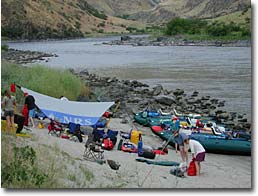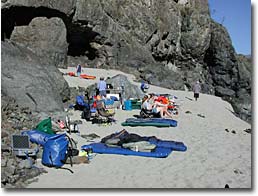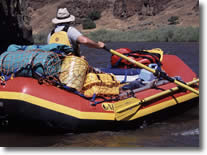Multiday Rafting Trips
ArticleJune 09, 2011
 Multiday trips in a raft or cataraft let you to travel in style! These inflatable boats can carry a lot of weight, allowing you to bring plenty of camping gear, food and people. Let’s cover some of the things you need to consider when preparing for a trip that takes you out overnight.
Multiday trips in a raft or cataraft let you to travel in style! These inflatable boats can carry a lot of weight, allowing you to bring plenty of camping gear, food and people. Let’s cover some of the things you need to consider when preparing for a trip that takes you out overnight.
Planning
The key to a successful multiday trip is good prior planning.
- You’re going to spend several days with these people. It pays to give some thought to selecting a compatible group.
- If you’re going to be exploring a new stretch of water, talk to others who’ve boated it and shop for up-to-date guidebooks and maps.
- Break the trip into distances that can easily be achieved in a normal day’s paddle, and allow for unexpected weather. Leave plenty of time to scout rapids, as well as playtime for kayakers and some special side hikes.
- On rivers where you can’t reserve campsites ahead of time, it’s good to have a second campsite choice ready in case the one you want most is taken.
- The size of your boat will determine how many folks and how much gear you can bring with you. See “How to Choose Your First Raft or Cataraft” for some guidelines on carrying capacity.
Getting Organized
- Convene your group well before the trip to discuss arrangements for meals, transportation and shuttles, costs, and group equipment and responsibilities.
- You may want to collect non-refundable deposits to minimize those last minute back-outs that complicate logistics and expenses.
- An excellent resource for all aspects of putting your trip together is the “River Otter Handbook for Planning.” There are hundreds of helpful tips in this book.
Camping Gear
 Realistically, you need about the same amount of camping gear for a two-day jaunt as you do for that Grand Canyon marathon. The tents, sleeping bags, sleeping pads, cooking and cleanup items, tables, chairs, etc are needed in any event. For a longer trip, basically you need a few more clothes, a lot more food and water, and more human waste carry-out capacity.
Realistically, you need about the same amount of camping gear for a two-day jaunt as you do for that Grand Canyon marathon. The tents, sleeping bags, sleeping pads, cooking and cleanup items, tables, chairs, etc are needed in any event. For a longer trip, basically you need a few more clothes, a lot more food and water, and more human waste carry-out capacity.- Plastic bail buckets, which were so handy for carrying water and washing dishes, are no longer needed for self-bailing rafts and catarafts. The Bail Pail and Big Basin are tough, collapsible substitutes.
- If you’re planning on doing some cooking over a wood fire or charcoal, or just having an evening campfire, you need a firepan. Fires built on the ground leave scars on the landscape. Bring a sturdy, watertight container for packing out the ashes.
- Even if it’s not required where you’re boating, you should bring a toilet system and pack out all of your solid human waste. Check with any regulating agency for their requirements.
- You also need to pack out all your garbage; be a good steward and separate out recyclable items. Garbage can be packed in coolers and other containers as they are emptied of food and other disposables.
- Refer to the “NRS Gear Checklists” for specific suggestions on items to bring. If traveling on water that is permitted or regulated by a government agency, check ahead to see what items they require.
Food: Planning and Packing
- If possible, plan menus with the entire group. Check to see if anyone has dietary restrictions, food allergies, is vegetarian, etc. Decide if all food will be “community”, i.e. purchased together and costs split equally or if individuals will be expected to provide part of the food at their own expense. Some groups divide up the evening meals and have individuals or cooking groups provide the ingredients.
- However the food shopping is done, making good lists will pay dividends. Don’t forget things like coffee, tea, condiments, garbage bags, soap, stove fuel and paper products—especially the toilet paper!
- Pack dry boxes and other containers with heavy items, such as canned goods, on bottom, lighter items like bread on top. Avoid glass containers; transfer contents to plastic ones.
- Ease the garbage carryout by eliminating extra packaging; transfer dry mixes into Ziploc bags; cut out cooking instructions and put them in the bags. Even in dry boxes, bag dry goods in plastic, just in case.
- Safely transporting refrigerated foods can be a challenge, especially in hot months and on long trips. High quality coolers are a must; they have good insulation and are tough. Freeze as much of your food and beverages as possible. Some canned beverages can be frozen and thawed successfully; experiment at home first.
- Using frozen containers of water instead of blocks of ice, gives you fresh water toward the end of the trip and keeps water out of the cooler. Pack food in the coolers, bottom to top, in the order they’re to be used and open the coolers as little as possible.
- Wrapping coolers in an absorbent material that you keep wet will help extend your ice. A cooler of all frozen items can be really extended by packing some dry ice in it and duct taping the lid seams.
- One good way to get early morning starts is to bring a folding camp oven, like the one Coleman makes. Breakfast burritos and egg-and-muffin type sandwiches can be wrapped in aluminum foil and heated with little cleanup, and toaster pastries and bagels warm up quickly in the oven.
- Other groups prefer a simpler breakfast strategy, in which hot water for tea, coffee and instant oatmeal are available in the mornings, but group members each make their own cold breakfasts.
Secure Your Cargo
 Overnight trips require carrying a lot of gear and convenient ways to lash it down. Raft cargo platforms and cataraft cargo floors are made of a high-strength mesh that supports your gear while letting water drain quickly.
Overnight trips require carrying a lot of gear and convenient ways to lash it down. Raft cargo platforms and cataraft cargo floors are made of a high-strength mesh that supports your gear while letting water drain quickly.- Strap your load down with a cargo net. On a raft you can fasten a cargo net to your frame by threading it on an end crossbar and then threading loop straps along both sides to secure the load.
- You can also attach a cargo net between two crossbars of your frame to make a sling for gear; the extra length of the net can then be draped over the load to secure it.
- And, of course, world-famous NRS cam straps are an indispensable part of any rafting trip!
- Even out the weight you carry on your boat from front to back, as well as from side to side. If your boat is too light in the front, you’re more likely to flip in whitewater.
- Uneven cargo distribution from side to side can make maneuvering in rapids more difficult.
- Keep in mind that your heaviest cargo often consists of passengers, and distribute your load accordingly.
- Less experienced rafters should travel lighter. Distribute group equipment fairly among experienced boaters in your group so that no one carries too much or too little for his or her skill level.
Be Prepared
- Keep your foul-weather gear handy at all times in a small dry bag that can be clipped or strapped securely in an accessible place. Even during the warm summer months, a steady rain can make a trip miserably cold.
- You may want to pack extra wetsuits, splash wear and base insulating layers just in case, and remember that passengers will be the first to get chilled. It’s good to carry a space blanket or bivvy sack in case someone gets dangerously cold and needs an emergency warm-up.
- By all means, each boat should carry a basic medical kit and someone should have a very complete one. Know how to use the kits; organizations like the Red Cross offer first aid and CPR classes.
- Check ahead of time to see if anyone has bee sting or other types of allergies that can lead to dangerous reactions (anaphylaxis or anaphylactic shock). It they carry epinephrine (an “epi-pin” kit) make sure others know about the kit and get instructions on how to use it if needed.
- Multiday trips, especially those in remote areas, offer unique challenges and rewards. Do your homework, prepare for emergencies and don’t tackle water beyond your experience level.
Kids and Dogs
- Both can be fun to have along on a trip, it it’s an appropriate one for them.
- Having children on a river trip calls for some special planning. Make sure each has a properly fitting life jacket, and bring extras. Be sure kids wear life jackets whenever they’re on or around the water, even in camp—you can’t possibly watch them every second. See Boating Safety for Infants & Small Children for tips on deciding when it’s wise to bring kids along.
- See Boating Safety for Man’s Best Friend for help in deciding when Fido should join you on the water.
Multiday boating lets you see amazing country that can be accessed no other way. Boat safe, have fun—see you on the water!
 NRS Gift Card: Always Fits, Always Wanted
NRS Gift Card: Always Fits, Always Wanted




